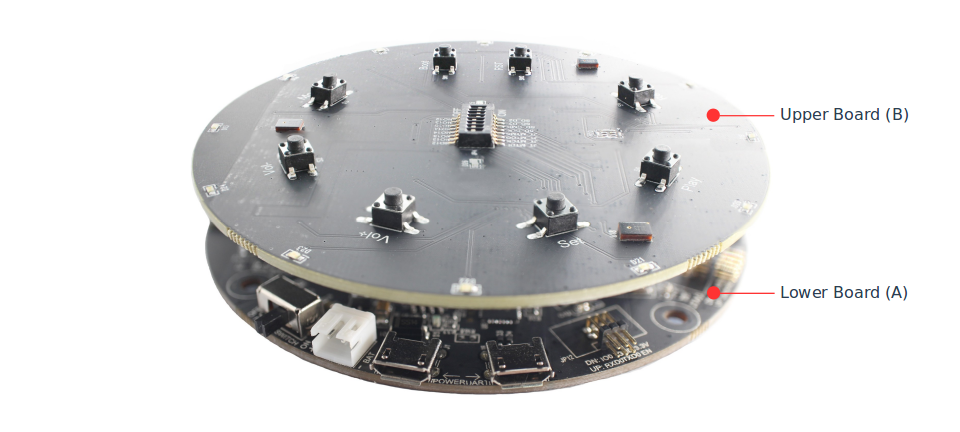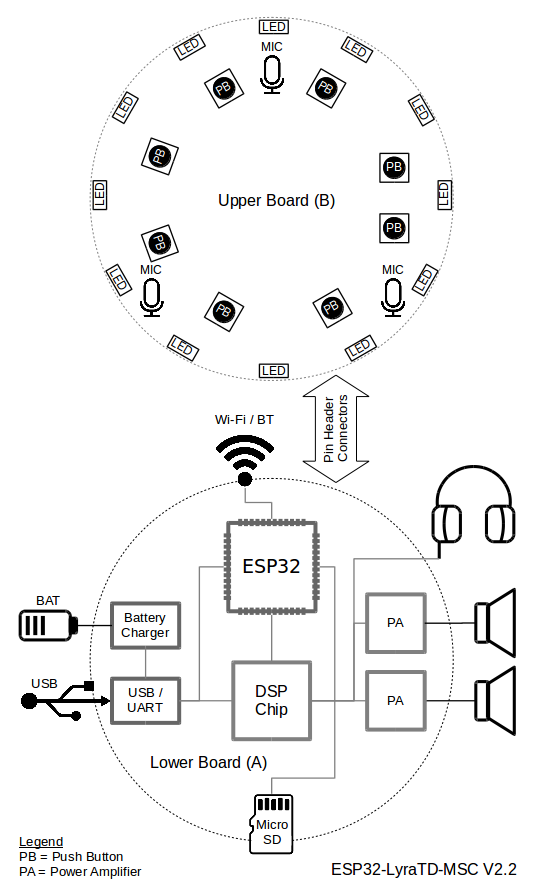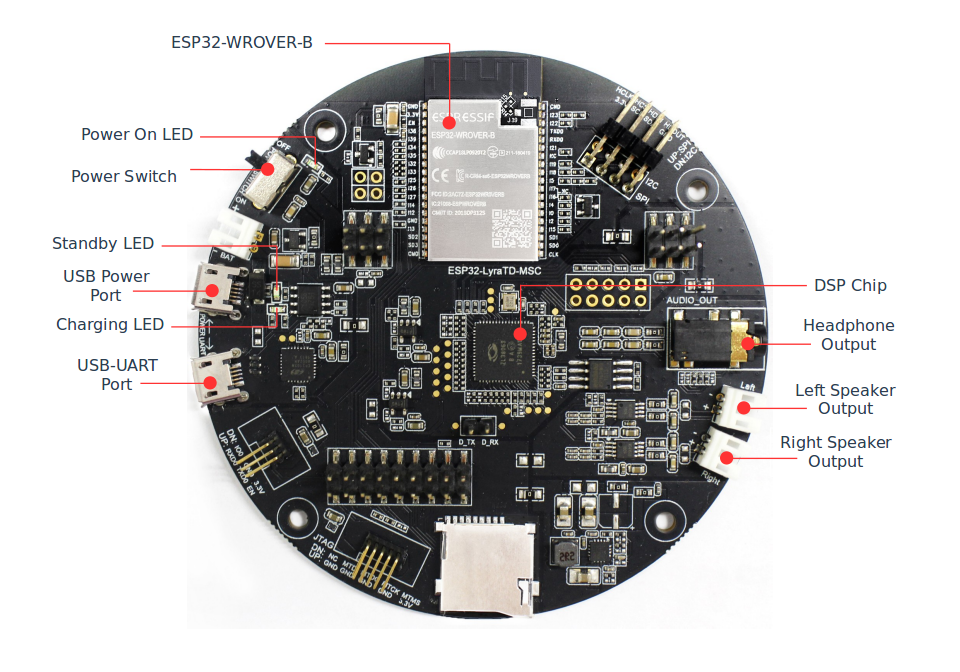ESP32-LyraTD-MSC V2.2 Getting Started Guide¶
This guide provides users with functional descriptions, configuration options for ESP32-LyraTD-MSC V2.2 audio development board, as well as how to get started with the ESP32-LyraTD-MSC board.
The ESP32-LyraTD-MSC is a hardware platform designed for smart speakers and AI applications. It supports Acoustic Echo Cancellation (AEC), Automatic Speech Recognition (ASR), Wake-up Interrupt and Voice Interaction.
What You Need¶
- 1 × ESP32-LyraTD-MSC V2.2 board
- 2 x 4-ohm speakers with Dupont female jumper wires or headphones with a 3.5 mm jack
- 2 x Micro-USB 2.0 cables, Type A to Micro B
- 1 × PC loaded with Windows, Linux or Mac OS
If you like to start using this board right now, go directly to section Start Application Development.
Overview¶
The ESP32-LyraTD-MSC V2.2 is an audio development board produced by Espressif built around ESP32. It is intended for smart speakers and AI applications, by providing hardware for digital signal processing, microphone array and additional RAM on top of what is already onboard of the ESP32 chip.
This audio development board consists of two parts: the upper board (B), which provides a three-microphone array, function keys and LED lights; and the lower board (A), which integrates ESP32-WROVER-B, a MicroSemi Digital Signal Processing (DSP) chip, and a power management module.

ESP32-LyraTD-MSC Side View
The specific hardware includes:
- ESP32-WROVER-B Module
- DSP (Digital Signal Processing) chip
- Three digital Microphones that support far-field voice pick-up
- 2 x 3-watt Speaker output
- Headphone output
- MicroSD Card slot (1 line or 4 lines)
- Individually controlled Twelve LEDs distributed in a circle on the board’s edge
- Six Function Buttons that may be assigned user functions
- Several interface ports: I2S, I2C, SPI and JTAG
- Integrated USB-UART Bridge Chip
- Li-ion Battery-Charge Management
The block diagram below presents main components of the ESP32-LyraTD-MSC and interconnections between components.

ESP32-LyraTD-MSC Block Diagram
Components¶
The following list and figure describe key components, interfaces and controls of the ESP32-LyraTD-MSC used in this guide. This covers just what is needed now. For additional details please refer to schematics provided in Related Documents.
- ESP32-WROVER-B Module
- The ESP32-WROVER-B module contains ESP32 chip to provide Wi-Fi / BT connectivity and data processing power as well as integrates 32 Mbit SPI flash and 64 Mbit PSRAM for flexible data storage.
- DSP Chip
- The Digital Signal Processing chip ZL38063 is used for Automatic Speech Recognition (ASR) applications. It captures audio data from an external microphone array and outputs audio signals through its Digital-to-Analog-Converter (DAC) port.
- Headphone Output
Output socket to connect headphones with a 3.5 mm stereo jack.
Note
The socket may be used with mobile phone headsets and is compatible with OMPT standard headsets only. It does work with CTIA headsets. Please refer to Phone connector (audio) on Wikipedia.
- Left Speaker Output
- Output socket to connect 4 ohm speaker. The pins have a standard 2.54 mm / 0.1” pitch.
- Right Speaker Output
- Output socket to connect 4 ohm speaker. The pins have a standard 2.54 mm / 0.1” pitch.

ESP32-LyraTD-MSC V2.2 Lower Board (A) Components
- USB-UART Port
- Functions as the communication interface between a PC and the ESP32 WROVER module.
- USB Power Port
- Provides the power supply for the board.
- Standby / Charging LEDs
- The Standby green LED indicates that power has been applied to the Micro USB Port. The Charging red LED indicates that a battery connected to the Battery Socket is being charged.
- Power Switch
- Power on/off knob: toggling it right powers the board on; otherwise powers the board off.
- Power On LED
- Red LED indicating that Power Switch is turned on.

ESP32-LyraTD-MSC V2.2 Upper Board (B) Components
- Boot/Reset Buttons
Boot: holding down the Boot button and momentarily pressing the Reset button initiates the firmware upload mode. Then user can upload firmware through the serial port.
Reset: pressing this button alone resets the system.
Start Application Development¶
Before powering up the ESP32-LyraTD-MSC, please make sure that the board has been received in good condition with no obvious signs of damage. Both the lower A and the upper B board of the ESP32-LyraTD-MSC should be firmly connected together.
Initial Setup¶
Prepare the board for loading of the first sample application:
- Connect 4-ohm speakers to the Right and Left Speaker Output. Connecting headphones to the Headphone Output is an option.
- Plug in the Micro-USB cables to the PC and to both USB ports of the ESP32-LyraTD-MSC.
- The Standby LED (green) should turn on. Assuming that a battery is not connected, the Charging LED (red) will blink every couple of seconds.
- Toggle right the Power Switch.
- The red Power On LED should turn on.
If this is what you see on the LEDs, the board should be ready for application upload. Now prepare the PC by loading and configuring development tools what is discussed in the next section.
Develop Applications¶
If the ESP32-LyraTD-MSC is initially set up and checked, you can proceed with preparation of the development tools. Go to section Get Started, which will walk you through the following steps:
- Set up ESP-IDF in your PC that provides a common framework to develop applications for the ESP32 in C language;
- Get ESP-ADF to have the API specific for the audio applications;
- Setup Path to ESP-ADF to make the framework aware of the audio specific API;
- Start a Project that will provide a sample audio application for the ESP32-LyraTD-MSC board;
- Connect and Configure to prepare the application for loading;
- Build, Flash and Monitor this will finally run the application and play some music.